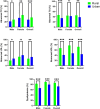Rural-urban differences in lipid abnormalities among middle-aged and older Indians
- PMID: 40847296
- PMCID: PMC12372319
- DOI: 10.1186/s12889-025-22625-3
Rural-urban differences in lipid abnormalities among middle-aged and older Indians
Abstract
Background: Dyslipidemia is a major risk factor for cardiovascular diseases (CVD). The prevalence of dyslipidemia varies by geographic location, often higher in urban populations. Our study aimed to assess the prevalence of dyslipidemia in the aging Indian population and compare the rural-urban differences in lipid abnormalities.
Methods: We analyzed baseline cross-sectional data from two longitudinal aging cohorts in rural and urban southern India- 2,797 participants from the rural (CBR-SANSCOG) cohort in Srinivaspura, Karnataka, and, 430 participants from the urban (CBR-TLSA) cohort in Bangalore, Karnataka. Participants aged ≥ 45 years were included, and those with dementia, severe psychiatric/medical illnesses, and severe visual/hearing impairments were excluded. Data on sociodemographic variables, physical activity, tobacco/alcohol use, BMI, diagnosis of diabetes, hypertension, and other medical comorbidities were collected. Lipid profiles were measured from fasting peripheral venous blood samples using standard laboratory techniques and lipid abnormalities were classified based on the NCEP ATP-III criteria. Proportions of lipid abnormalities were compared between the two populations using the two-proportions Z-test, and risk factors associated with dyslipidemia were analyzed using multivariate logistic regression models.
Results: The prevalence of high total cholesterol (TC), and low-density lipoprotein cholesterol (LDL-c) was significantly greater in the urban than rural population (TC: 37.0% vs. 28.4% p < 0.001 and LDL-c: 33.5% vs. 26.8%, p < 0.01, respectively), while the prevalence of low high-density lipoprotein cholesterol (HDL-c: 72.4% vs. 44.2%, p <0.001), high triglycerides (TG: 45.7% vs. 38.6%, p <0.01) and lipid risk ratios (TC/HDL-c, TG/HDL-c and LDL-c/HDL-c) was higher in the rural than urban population. Females in both urban and rural populations were at a higher risk of having multiple lipid abnormalities. For the other risk factors assessed, while diabetes, overweight, obesity, and physical inactivity were associated with increased risks for certain lipid abnormalities, these associations were less pronounced in the urban population.
Conclusions: Aging Indians, both in rural and urban settings, have an alarmingly high prevalence of lipid abnormalities. Considering an elevated cardiovascular disease risk associated with lipid abnormalities, targeted interventions towards these communities are necessary to reduce the disease burden.
Keywords: Dyslipidemia; India; Older population; Prevalence; Rural–urban differences.
© 2025. The Author(s).
Conflict of interest statement
Declarations. Ethics approval and consent to participate: This study involved human participants and was approved by CBR Institutional Ethics Committee. IEC Number: CBR/42/IEC/2022–23. Participants gave informed consent to participate in the study. Consent for publication: Not Applicable. Competing interests: The authors declare no competing interests.
Figures







References
-
- Maxfield FR, Tabas I. Role of cholesterol and lipid organization in disease. Nature. 2005;438(7068):612–21. - PubMed
-
- Wulff AB, Nordestgaard BG. Lipids and lipoproteins. Dan Med J. 2023;70(7):A03230185. PMID: 37381868. - PubMed
-
- Expert Panel on Detection E and T of HBC in A. Executive Summary of the Third Report of the National Cholesterol Education Program (NCEP) Expert Panel on Detection, Evaluation, and Treatment of High Blood Cholesterol in Adults (Adult Treatment Panel III). JAMA: The Journal of the American Medical Association. 2001;285(19):2486–97. - PubMed
-
- Soppert J, Lehrke M, Marx N, Jankowski J, Noels H. Lipoproteins and lipids in cardiovascular disease: from mechanistic insights to therapeutic targeting. Adv Drug Deliv Rev. 2020;159:4–33. - PubMed
Publication types
MeSH terms
Substances
LinkOut - more resources
Full Text Sources
Medical
Miscellaneous

